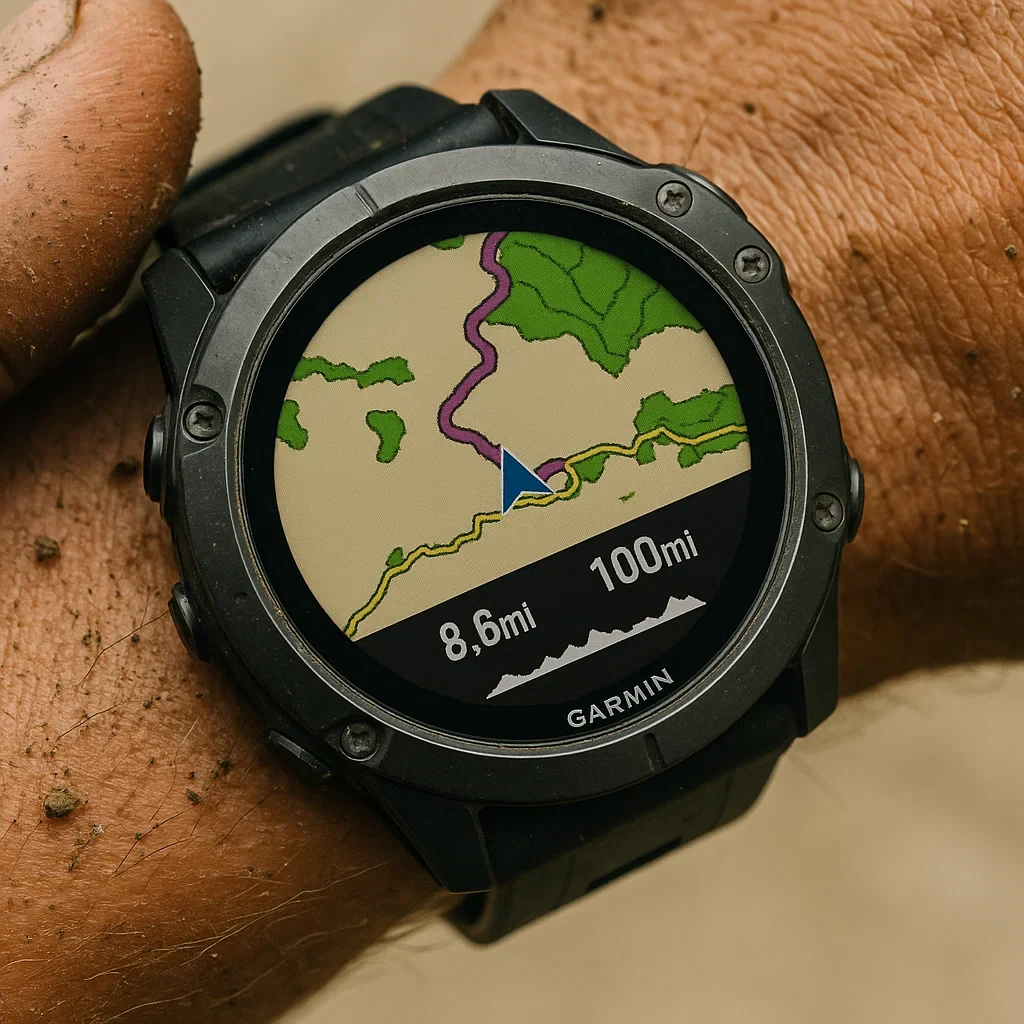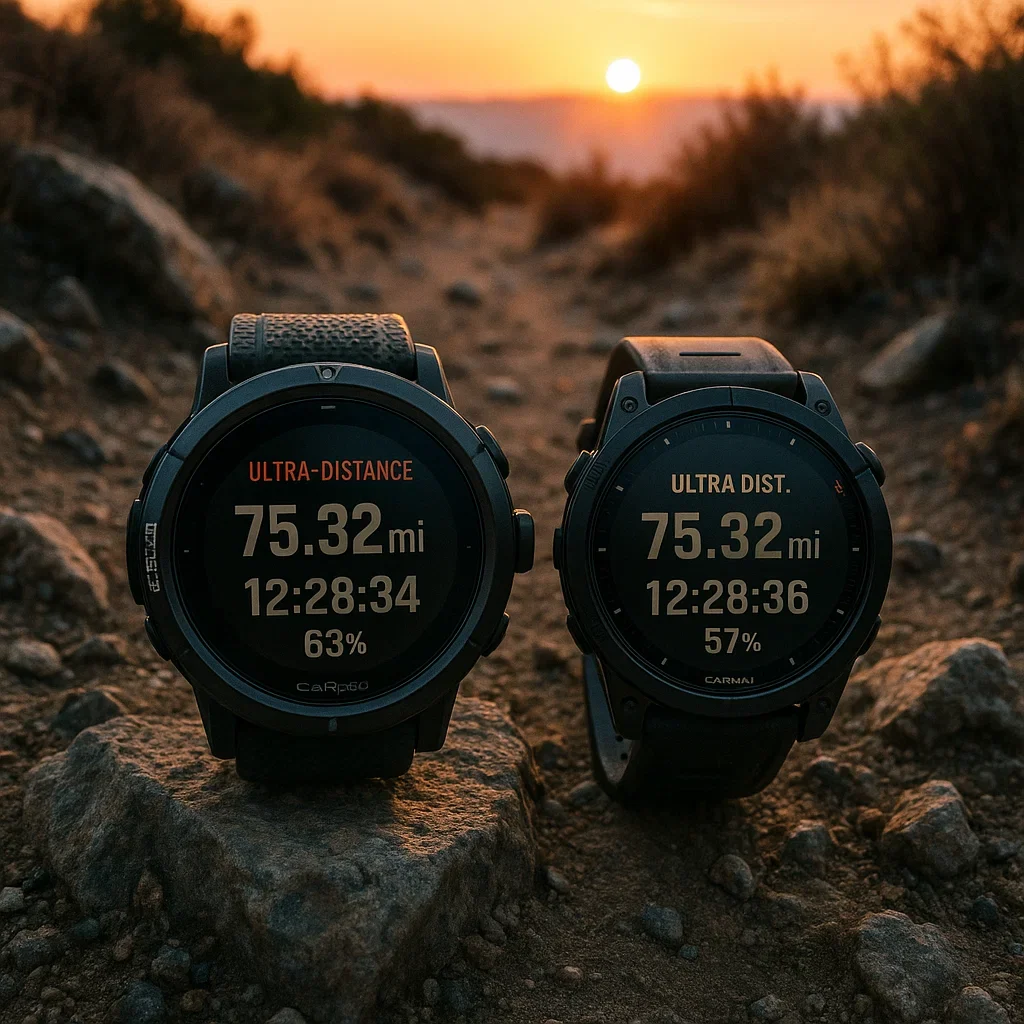Coros vs Garmin for 100 Mile Ultras: Best GPS Watch for Ultra Running 2025
Ready for the long haul?
Choosing the right GPS watch for a 100-mile ultramarathon can be the difference between a dream finish and a navigation nightmare. In 2025, the Coros vs Garmin ultra debate is hotter than ever.
This guide compares features, battery, mapping, accuracy, HRV, and real runner feedback so you can trust your wrist—no matter how wild the course.
Which ultra watch should you choose? Let’s dive into the ultimate Coros vs Garmin showdown!
This guide compares features, battery, mapping, accuracy, HRV, and real runner feedback so you can trust your wrist—no matter how wild the course.
Which ultra watch should you choose? Let’s dive into the ultimate Coros vs Garmin showdown!
🎯 What Ultra Runners Need from a 100-Mile GPS Watch
- Battery life for 24-48+ hours—no recharging at mile 80!
- Accurate GPS on trails, canyons, and mountains
- Navigation: breadcrumb, color mapping, route upload
- HR, HRV, and altitude tracking for pacing & safety
- Comfortable fit for 20-40 hours on your wrist
- Weatherproof and rugged—rain, mud, snow, and falls
- Easy app sync: Strava, Stryd, TrainingPeaks, HRV apps
🔋 Battery Life: Can Your Watch Go the Distance?
- Coros Vertix 2: Up to 140 hours GPS (UltraMax), 60+ hours full GPS—all race, no recharge.
- Garmin Fenix 7: 57 hours full GPS, up to 136 hours in “Expedition” mode; solar charging adds hours in sunlight.
- Real World: Both will finish most 100 milers, but Coros dominates battery benchmarks in “set-and-forget” mode.
🗺️ Navigation & Mapping: Don’t Get Lost!
- Garmin: Full-color topo maps, turn-by-turn navigation, off-route alerts—best for complex ultras
- Coros: Breadcrumb navigation, elevation profile, new global color maps (2025 update), route planner
- User Tip: Pre-load your GPX files and practice navigating before race day
🎯 Accuracy & Sensors: HRV, Altitude, GPS
- GPS: Both are multi-band/multi-GNSS for precision, even in canyons
- HRV: Garmin now has 24/7 HRV tracking, Coros has added morning HRV status (Vertix 2, Apex 2 Pro)
- Altitude: Barometric altimeters in both; Garmin edges ahead on storm alerts and altitude acclimation
🦾 Ease of Use, Comfort & Durability
- Coros: Lightweight, simple UI, big buttons—gloves no problem
- Garmin: Heavier but feature-packed, touch screen (Epix/Fenix 7), many menu options
- Both: Sapphire glass, titanium bezel, water-resistant, ultra-tough for mountain use
🔗 App Ecosystem & Data Sync
- Coros: Instant sync with Coros app, Stryd, Strava, TrainingPeaks, Final Surge, and Apple Health
- Garmin: Connects to Garmin Connect, Stryd, Strava, TrainingPeaks, HRV4Training, Runalyze, Apple Health, and more
- Both: Export .fit or .gpx files for deeper analysis or manual backup
- User Tip: If you love running data, both ecosystems are solid. Garmin is king for integrations; Coros is faster and simpler.
💸 Price & Value Comparison
- Coros Vertix 2: ~$699 USD
- Garmin Fenix 7: ~$799 USD (Pro/Solar editions higher); Epix models often $900+
- Garmin Forerunner 965: Budget-friendly, strong battery, fewer maps (often $599)
- Both brands: Lower models available, but for 100 milers, go premium if you want maximum reliability.
- Resale value: Garmin holds value longer; Coros is popular in ultra circles.
💬 Real Ultra Runners: Coros & Garmin Experiences
- Marcus L.: “My Coros Vertix lasted 38 hours in the Alps. Zero battery stress, super light!”
- Helena S.: “Garmin Fenix saved my UTMB when fog hit—the color maps kept me on course!”
- Toby N.: “Coros syncs to Stryd and Strava in seconds. But for city ultras, I prefer Garmin’s extra features.”
🏆 Which Is Best? Verdict for 2025
- Choose Coros if: You want unbeatable battery, simple UI, and a lightweight ultra-tough design
- Choose Garmin if: You need full-color maps, extra metrics, advanced HRV/sleep, and integrations galore
- Both are proven for 100-mile (and longer) ultras—choose based on your own style, app loyalty, and navigation needs
❓ Coros vs Garmin: Ultra FAQ
Can I use both watches for the same race?
Yes—many runners “dual-wear” to compare stats, battery, and navigation. Not required, but great for data nerds!
Which is better for mountain/remote ultras?
Coros wins on battery, Garmin wins on mapping and weather alerts—choose based on your race’s wildness!
Does Coros or Garmin sync with Stryd, HRV apps, Strava?
Both do—Garmin has more integrations, but Coros is catching up quickly.
What about after-sales support?
Garmin has global support and longer track record; Coros is responsive and has a loyal ultra community.
🔗 Further Reading & Resources
AI Coaching & Wearable Tech in Ultramarathon
How smart watches & apps shape ultra success. Stryd Critical Power Explained
Combine power and GPS for perfect pacing. Best HRV Apps for Ultra Runners
HRV, recovery, and readiness tools for every runner. Ultra Recovery Strategies
Optimize your recovery with data-driven approaches.
How smart watches & apps shape ultra success. Stryd Critical Power Explained
Combine power and GPS for perfect pacing. Best HRV Apps for Ultra Runners
HRV, recovery, and readiness tools for every runner. Ultra Recovery Strategies
Optimize your recovery with data-driven approaches.
🏁 Final Thoughts: Trust Your Gear, Trust Your Training
Whether you go Coros or Garmin, you’re investing in more than a watch—you’re investing in your adventure.
Battery, mapping, and ultra-tested reliability mean you can focus on running, not troubleshooting.
Test your gear, charge it up, and line up with confidence. The best watch is the one that gets you to the finish—mile after mile, no matter what the trail brings.
Have you raced 100 miles with Coros or Garmin? Drop your story in the comments, or check out our next ultra-tech guide for more trail-tested wisdom!
Test your gear, charge it up, and line up with confidence. The best watch is the one that gets you to the finish—mile after mile, no matter what the trail brings.
Have you raced 100 miles with Coros or Garmin? Drop your story in the comments, or check out our next ultra-tech guide for more trail-tested wisdom!


About the Author
Lost Pace is an ultramarathon runner, shoe-tester and the founder of umit.net. Based year-round in Türkiye’s rugged Kaçkar Mountains, he has logged 10,000 + km of technical trail running and completed multiple 50 K–100 K ultras.
Blending mountain grit with data, Lost analyses power (CP 300 W), HRV and nutrition to craft evidence-backed training plans. He has co-written 260 + long-form guides on footwear science, recovery and endurance nutrition, and is a regular beta-tester of AI-driven coaching tools.
When he isn’t chasing PRs or testing midsoles, you’ll find him sharing peer-reviewed research in plain English to help runners train smarter, stay healthier and finish stronger.
Ultrarunner · Data geek · Vegan athlete

